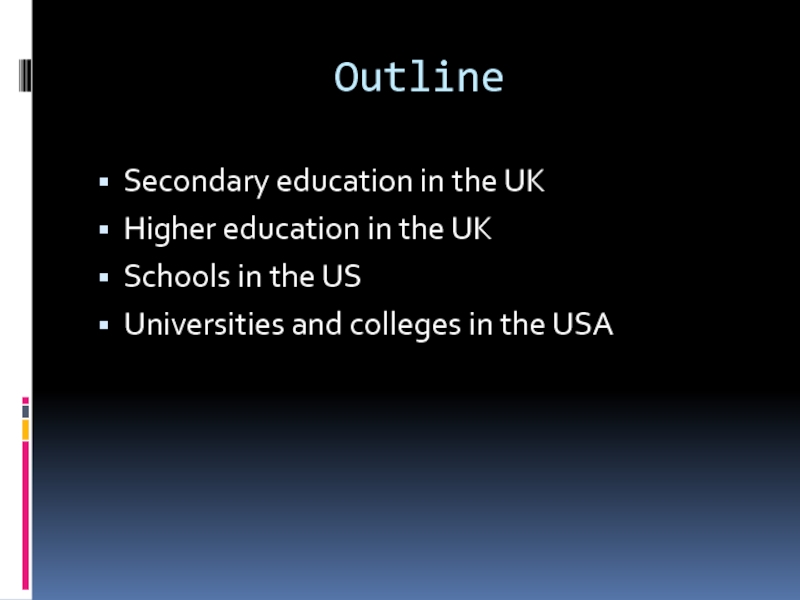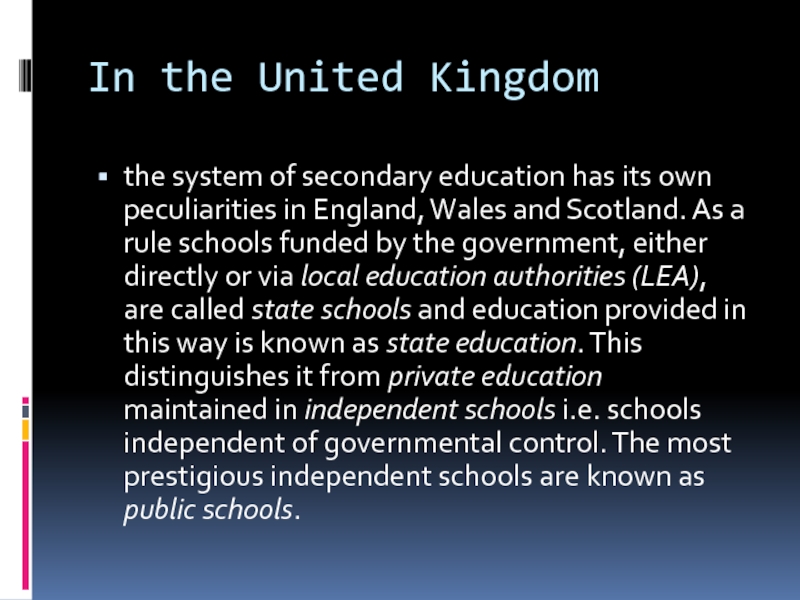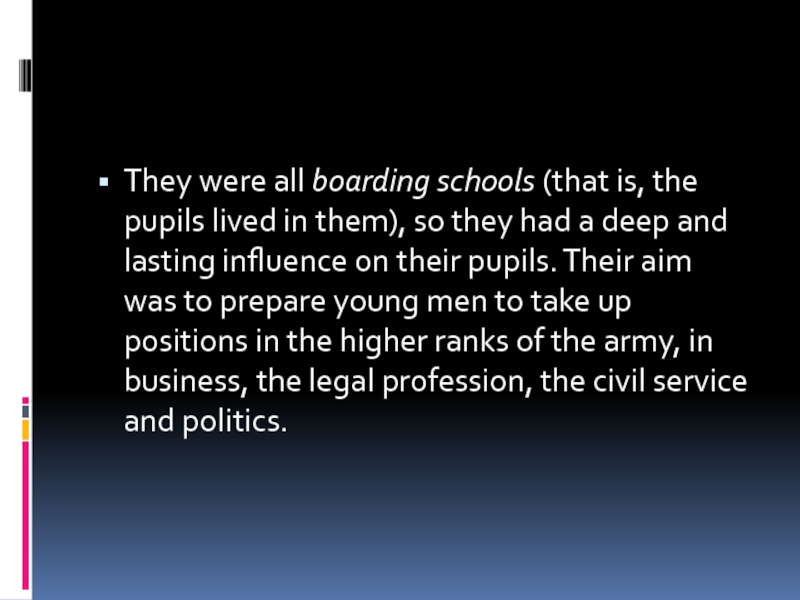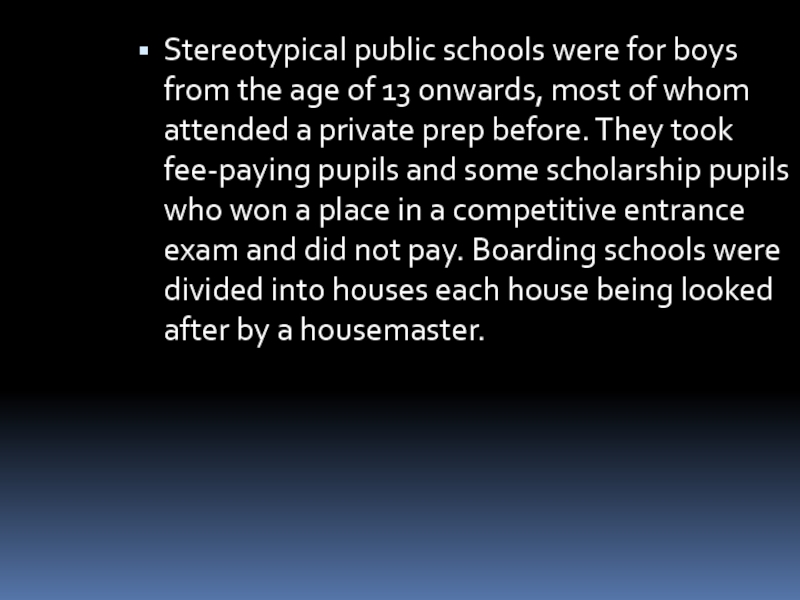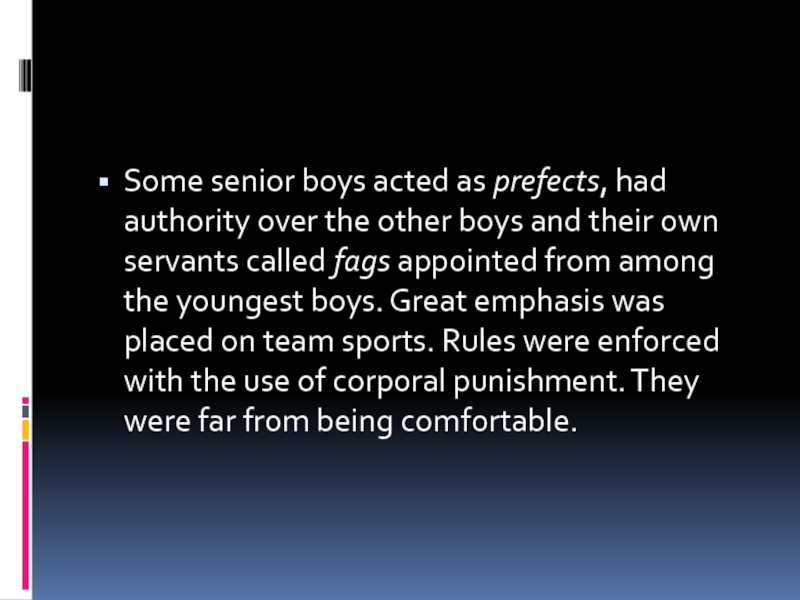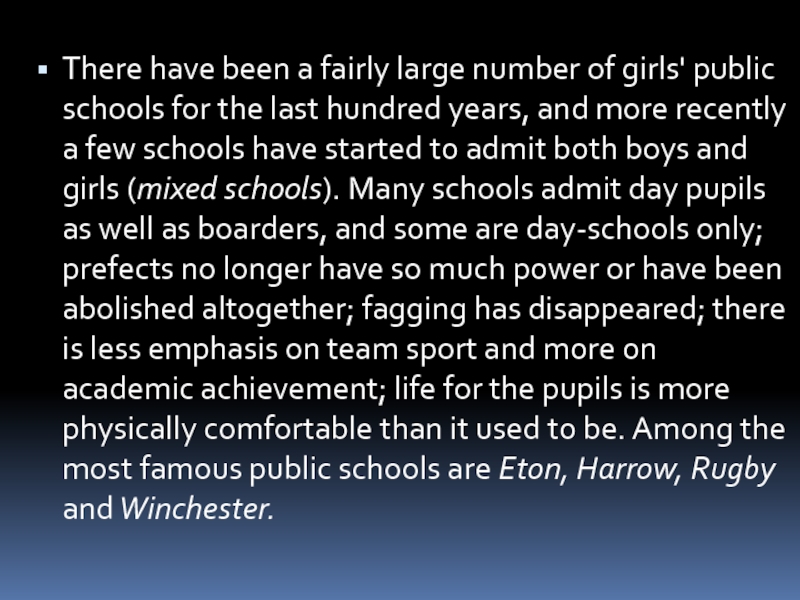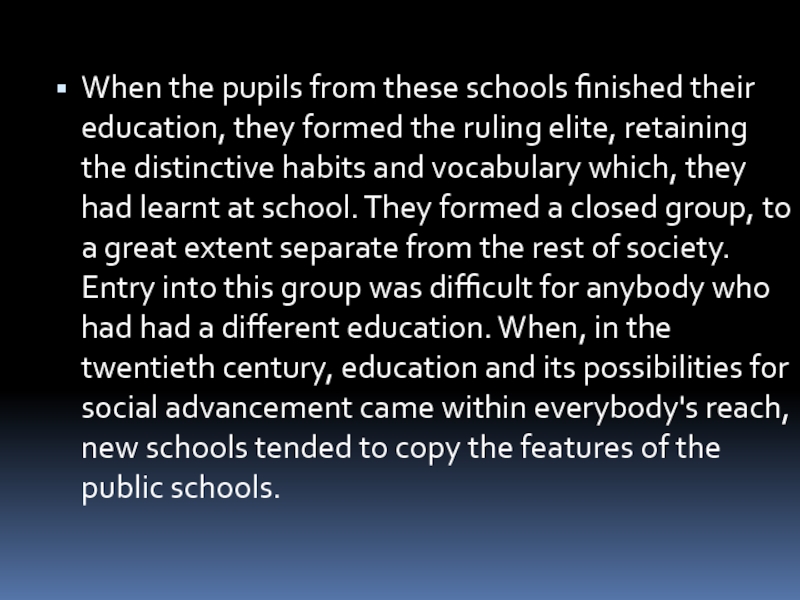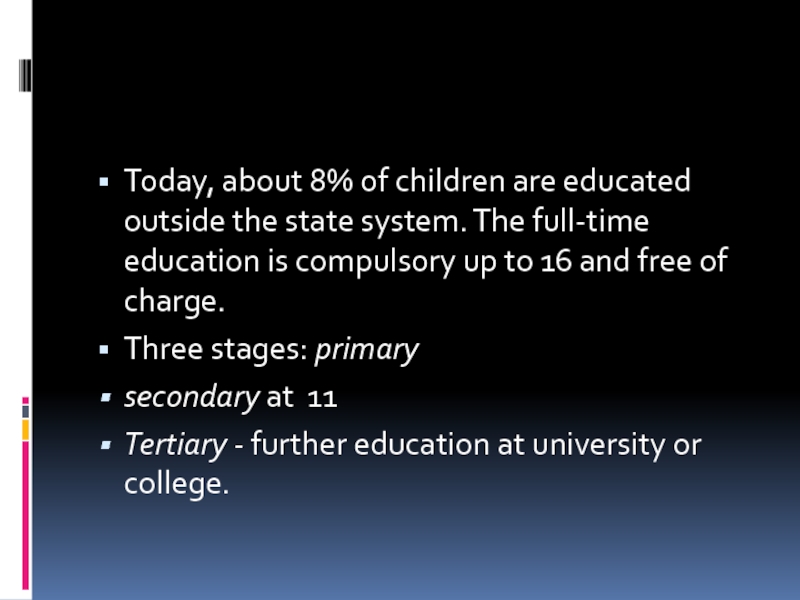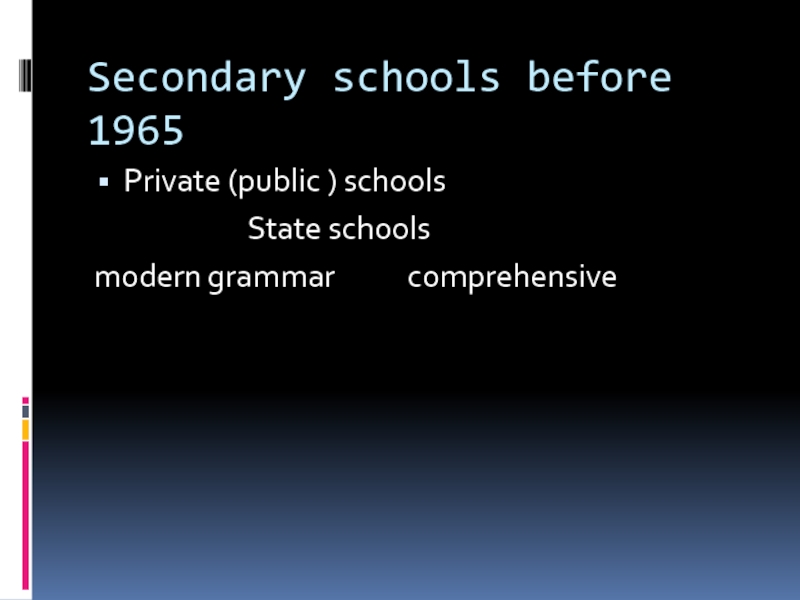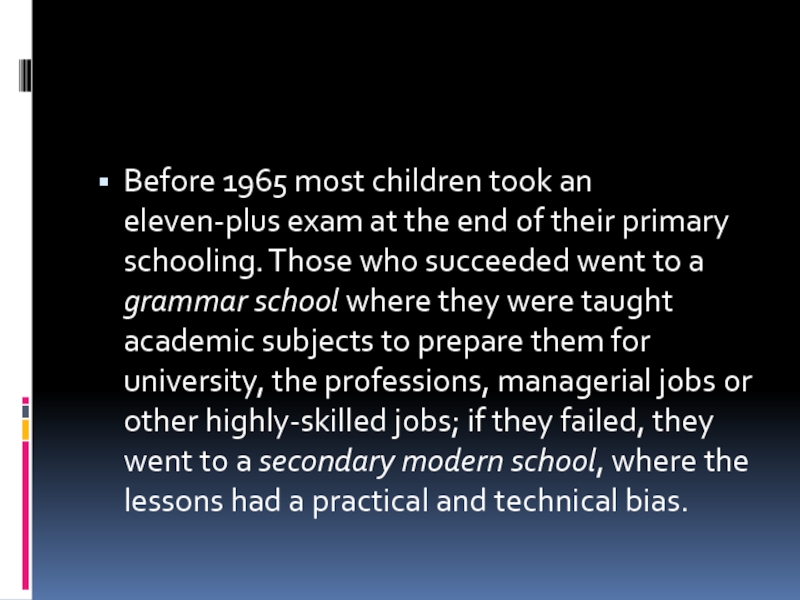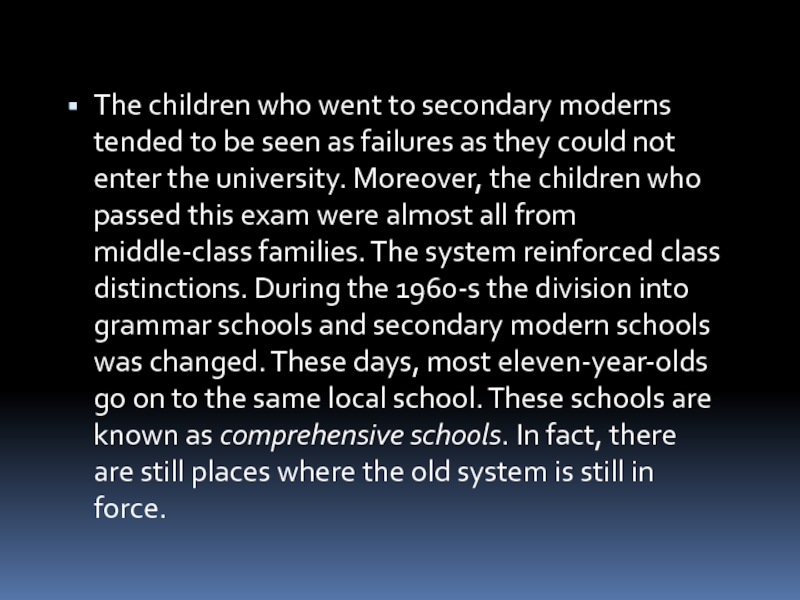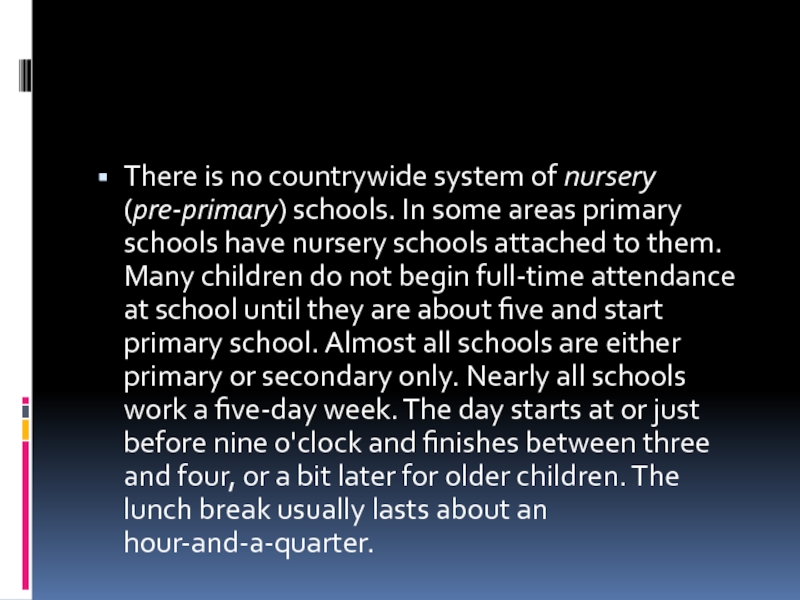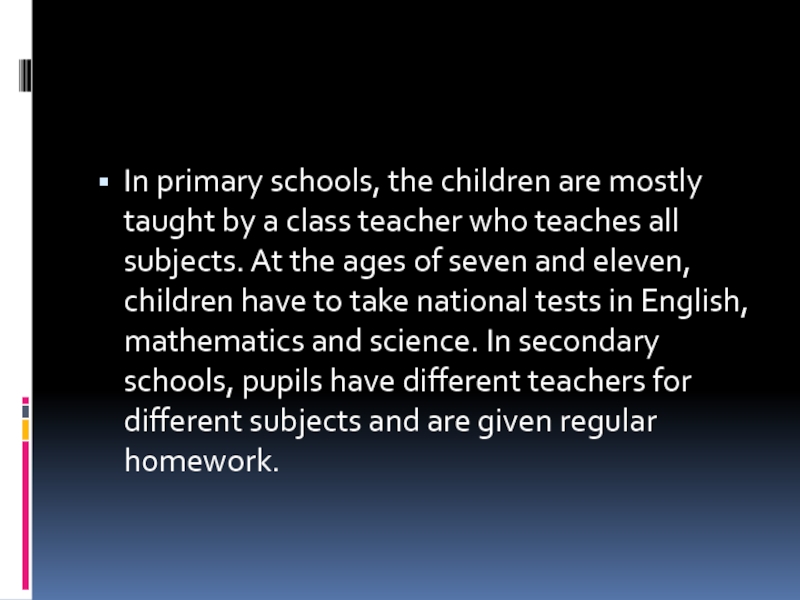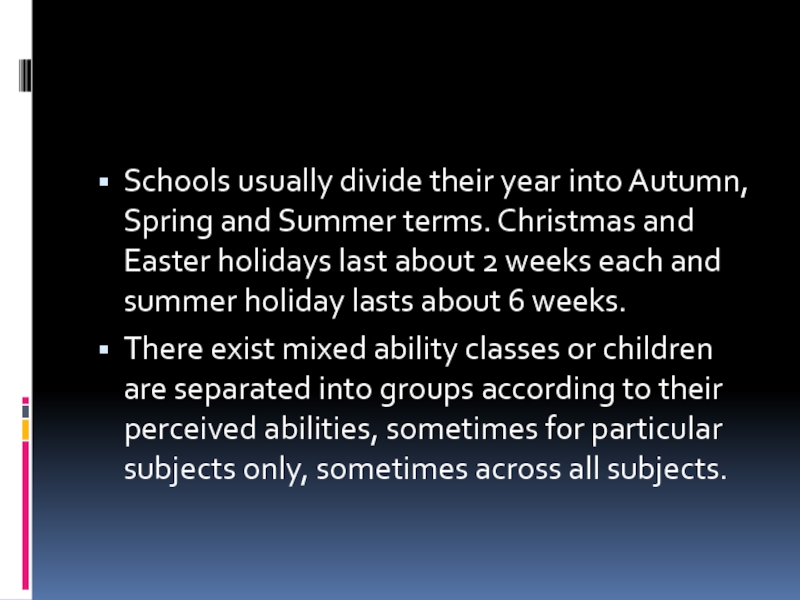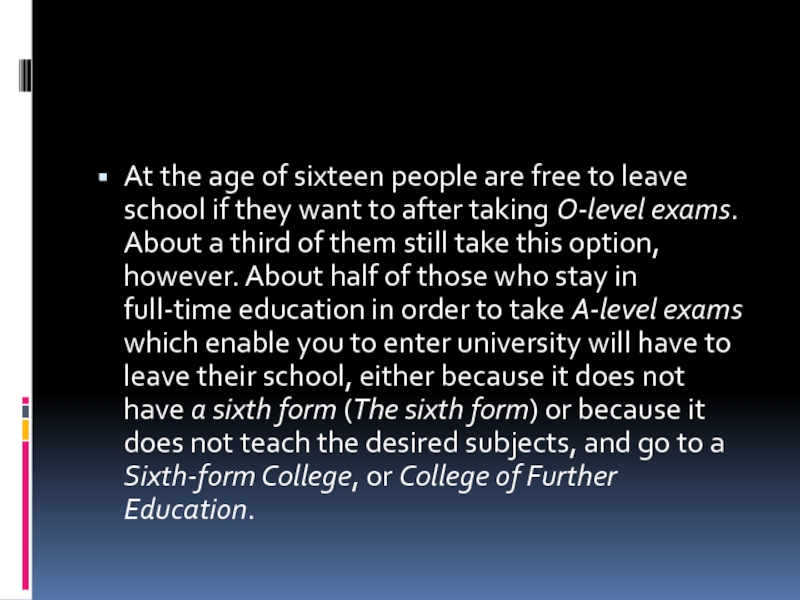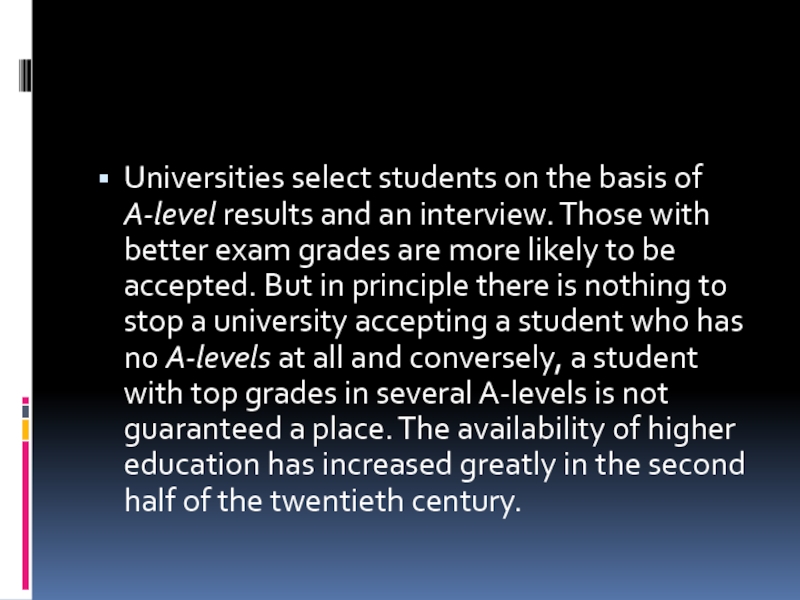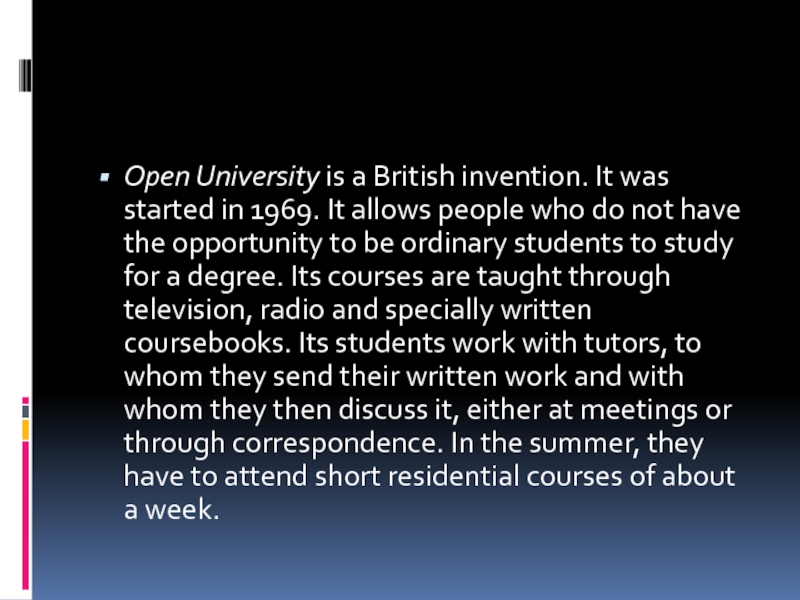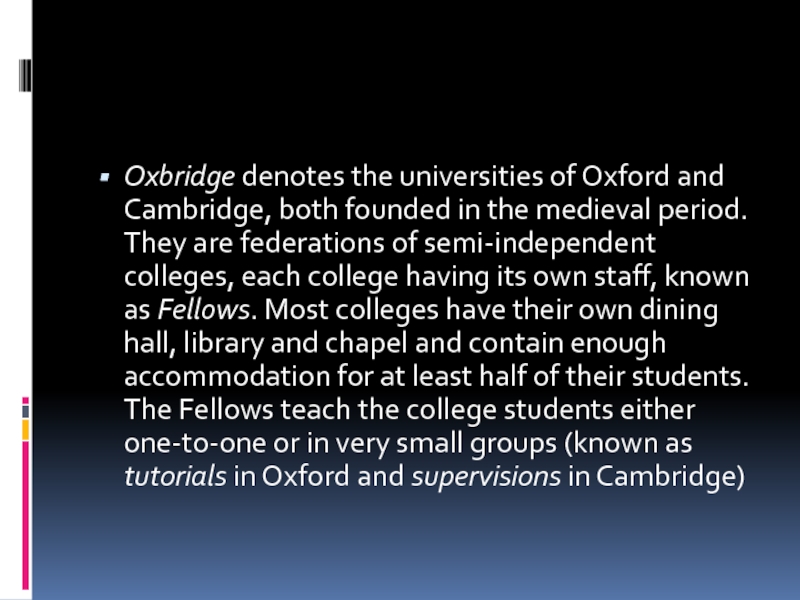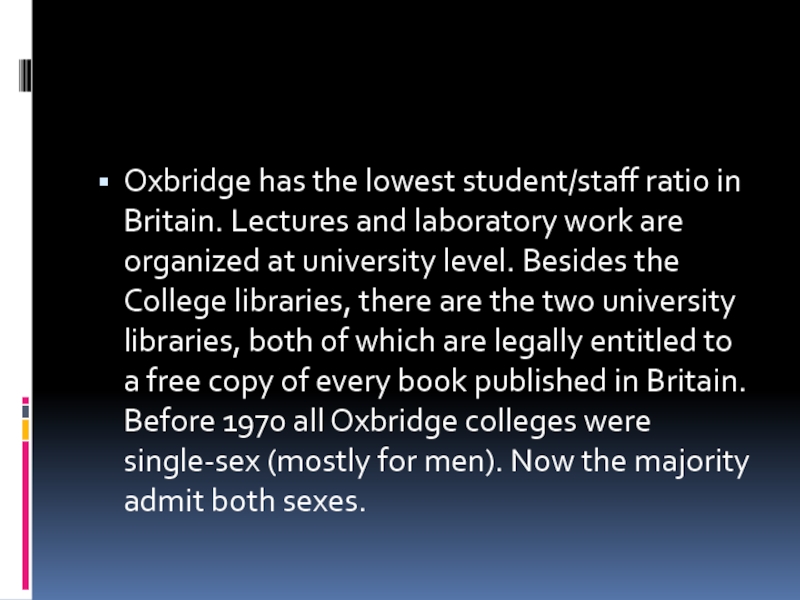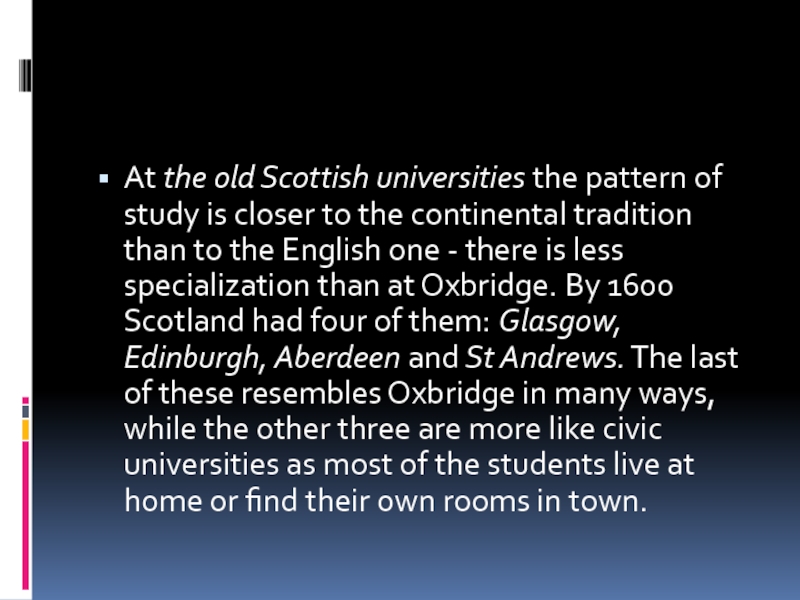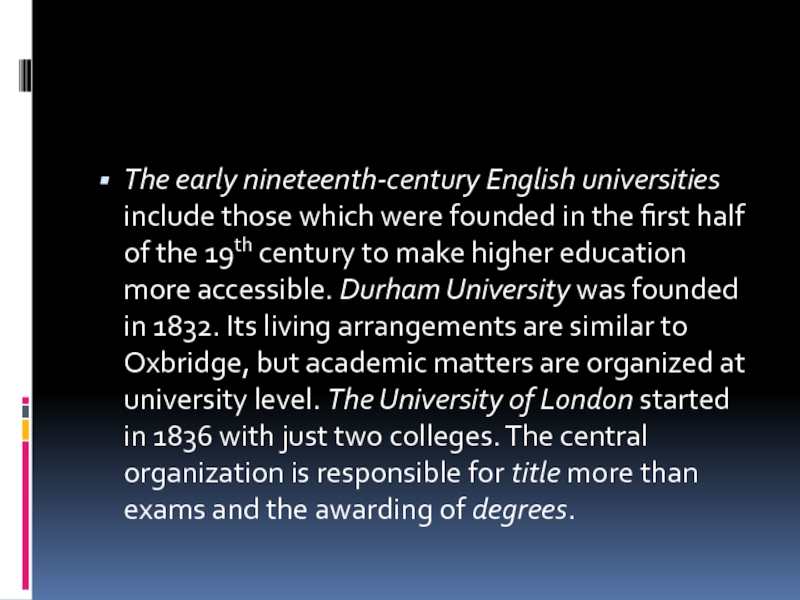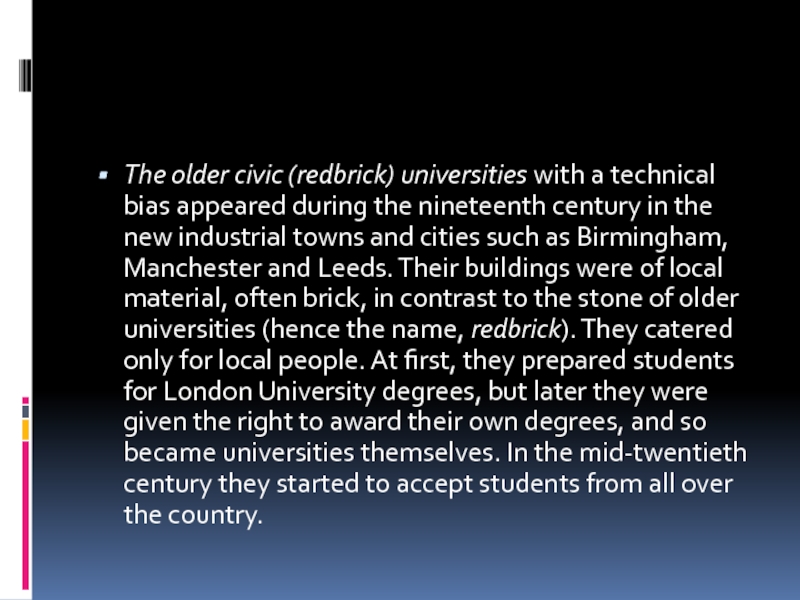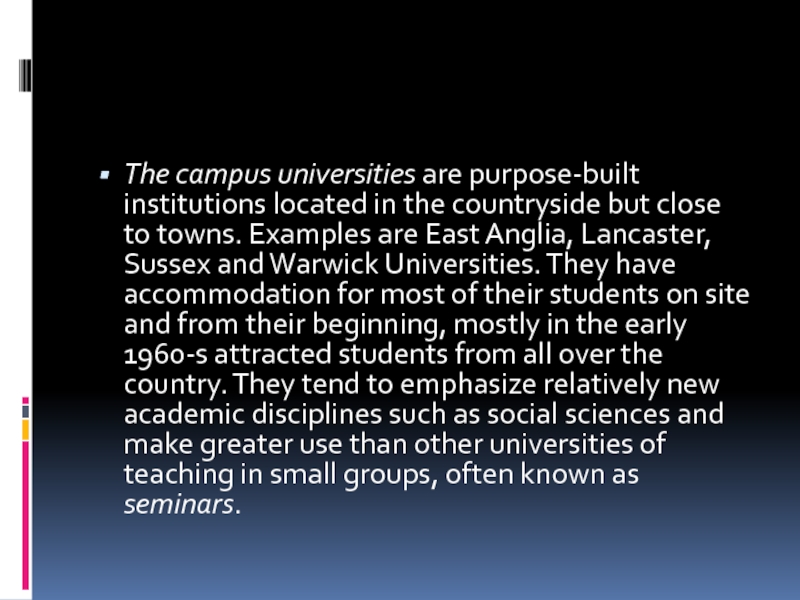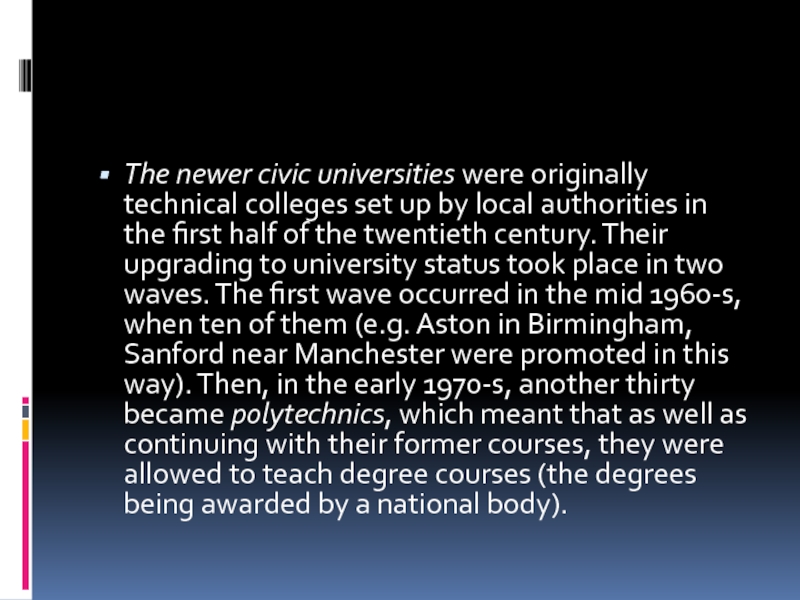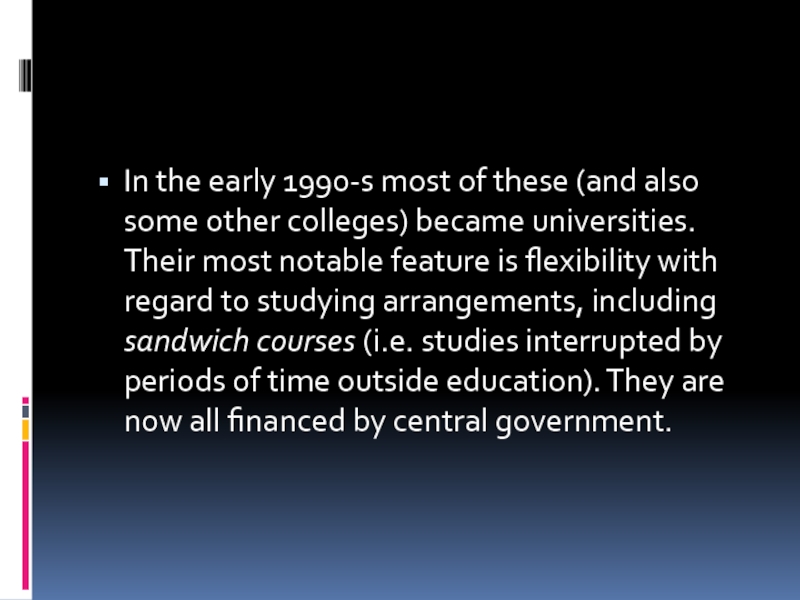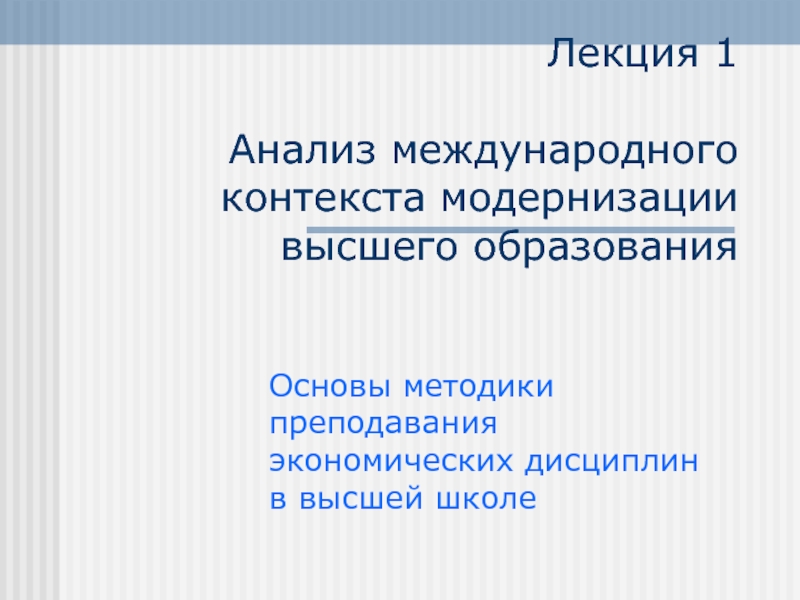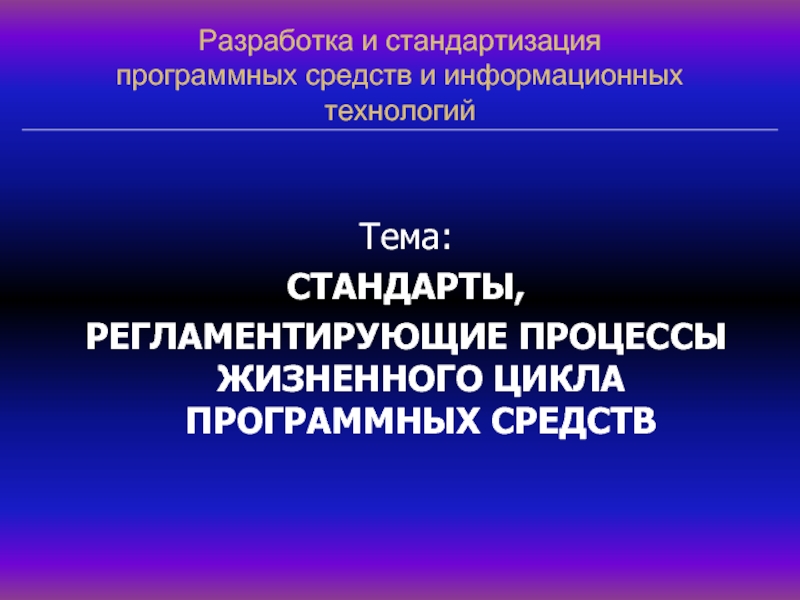- Главная
- Разное
- Дизайн
- Бизнес и предпринимательство
- Аналитика
- Образование
- Развлечения
- Красота и здоровье
- Финансы
- Государство
- Путешествия
- Спорт
- Недвижимость
- Армия
- Графика
- Культурология
- Еда и кулинария
- Лингвистика
- Английский язык
- Астрономия
- Алгебра
- Биология
- География
- Детские презентации
- Информатика
- История
- Литература
- Маркетинг
- Математика
- Медицина
- Менеджмент
- Музыка
- МХК
- Немецкий язык
- ОБЖ
- Обществознание
- Окружающий мир
- Педагогика
- Русский язык
- Технология
- Физика
- Философия
- Химия
- Шаблоны, картинки для презентаций
- Экология
- Экономика
- Юриспруденция
Education as a source of background vocabulary презентация
Содержание
- 1. Education as a source of background vocabulary
- 2. Outline Secondary education in the UK Higher
- 3. In the United Kingdom the system
- 4. At public schools the emphasis was
- 5. They were all boarding schools (that
- 6. Stereotypical public schools were for boys from
- 7. Some senior boys acted as prefects,
- 8. There have been a fairly large number
- 9. When the pupils from these schools finished
- 10. Today, about 8% of children are
- 11. Secondary schools before 1965 Private (public ) schools State schools modern grammar comprehensive
- 12. Before 1965 most children took an
- 13. The children who went to secondary moderns
- 14. A national curriculum appeared in the
- 15. There is no countrywide system of
- 16. In primary schools, the children are
- 17. Schools usually divide their year into
- 18. At the age of sixteen people
- 19. Everywhere except Scotland (which has its
- 20. Universities select students on the basis
- 21. Open University is a British invention.
- 22. Oxbridge denotes the universities of Oxford
- 23. Oxbridge has the lowest student/staff ratio
- 24. At the old Scottish universities the
- 25. The early nineteenth-century English universities include
- 26. The older civic (redbrick) universities with
- 27. The campus universities are purpose-built institutions
- 28. The newer civic universities were originally
- 29. In the early 1990-s most of
Слайд 2Outline
Secondary education in the UK
Higher education in the UK
Schools in the
US
Universities and colleges in the USA
Universities and colleges in the USA
Слайд 3In the United Kingdom
the system of secondary education has its
own peculiarities in England, Wales and Scotland. As a rule schools funded by the government, either directly or via local education authorities (LEA), are called state schools and education provided in this way is known as state education. This distinguishes it from private education maintained in independent schools i.e. schools independent of governmental control. The most prestigious independent schools are known as public schools.
Слайд 4At public schools
the emphasis was on character-building and the development
of team spirit rather than on academic achievement. This involved the development of customs and attitudes, the wearing of distinctive clothes and the use of specialized items of vocabulary.
Слайд 5
They were all boarding schools (that is, the pupils lived in
them), so they had a deep and lasting influence on their pupils. Their aim was to prepare young men to take up positions in the higher ranks of the army, in business, the legal profession, the civil service and politics.
Слайд 6Stereotypical public schools were for boys from the age of 13
onwards, most of whom attended a private prep before. They took fee-paying pupils and some scholarship pupils who won a place in a competitive entrance exam and did not pay. Boarding schools were divided into houses each house being looked after by a housemaster.
Слайд 7
Some senior boys acted as prefects, had authority over the other
boys and their own servants called fags appointed from among the youngest boys. Great emphasis was placed on team sports. Rules were enforced with the use of corporal punishment. They were far from being comfortable.
Слайд 8There have been a fairly large number of girls' public schools
for the last hundred years, and more recently a few schools have started to admit both boys and girls (mixed schools). Many schools admit day pupils as well as boarders, and some are day-schools only; prefects no longer have so much power or have been abolished altogether; fagging has disappeared; there is less emphasis on team sport and more on academic achievement; life for the pupils is more physically comfortable than it used to be. Among the most famous public schools are Eton, Harrow, Rugby and Winchester.
Слайд 9When the pupils from these schools finished their education, they formed
the ruling elite, retaining the distinctive habits and vocabulary which, they had learnt at school. They formed a closed group, to a great extent separate from the rest of society. Entry into this group was difficult for anybody who had had a different education. When, in the twentieth century, education and its possibilities for social advancement came within everybody's reach, new schools tended to copy the features of the public schools.
Слайд 10
Today, about 8% of children are educated outside the state system.
The full-time education is compulsory up to 16 and free of charge.
Three stages: primary
secondary at 11
Tertiary - further education at university or college.
Three stages: primary
secondary at 11
Tertiary - further education at university or college.
Слайд 11Secondary schools before 1965
Private (public ) schools
State schools
modern grammar comprehensive
Слайд 12
Before 1965 most children took an eleven-plus exam at the end
of their primary schooling. Those who succeeded went to a grammar school where they were taught academic subjects to prepare them for university, the professions, managerial jobs or other highly-skilled jobs; if they failed, they went to a secondary modern school, where the lessons had a practical and technical bias.
Слайд 13The children who went to secondary moderns tended to be seen
as failures as they could not enter the university. Moreover, the children who passed this exam were almost all from middle-class families. The system reinforced class distinctions. During the 1960-s the division into grammar schools and secondary modern schools was changed. These days, most eleven-year-olds go on to the same local school. These schools are known as comprehensive schools. In fact, there are still places where the old system is still in force.
Слайд 14
A national curriculum appeared in the late 1980-s. Besides schools can
now get their money directly from central government. At the lower primary level, this means a greater emphasis on what are known as the three Rs (Reading, wRiting and aRithmetic). At higher levels, it means a greater emphasis on science and technology. A consequence of the traditional British approach to education had been the habit of giving a relatively large amount of attention to the arts and humanities, and relatively little to science and technology.
Слайд 15
There is no countrywide system of nursery (pre-primary) schools. In some
areas primary schools have nursery schools attached to them. Many children do not begin full-time attendance at school until they are about five and start primary school. Almost all schools are either primary or secondary only. Nearly all schools work a five-day week. The day starts at or just before nine o'clock and finishes between three and four, or a bit later for older children. The lunch break usually lasts about an hour-and-a-quarter.
Слайд 16
In primary schools, the children are mostly taught by a class
teacher who teaches all subjects. At the ages of seven and eleven, children have to take national tests in English, mathematics and science. In secondary schools, pupils have different teachers for different subjects and are given regular homework.
Слайд 17
Schools usually divide their year into Autumn, Spring and Summer terms.
Christmas and Easter holidays last about 2 weeks each and summer holiday lasts about 6 weeks.
There exist mixed ability classes or children are separated into groups according to their perceived abilities, sometimes for particular subjects only, sometimes across all subjects.
There exist mixed ability classes or children are separated into groups according to their perceived abilities, sometimes for particular subjects only, sometimes across all subjects.
Слайд 18
At the age of sixteen people are free to leave school
if they want to after taking O-level exams. About a third of them still take this option, however. About half of those who stay in full-time education in order to take A-level exams which enable you to enter university will have to leave their school, either because it does not have a sixth form (The sixth form) or because it does not teach the desired subjects, and go to a Sixth-form College, or College of Further Education.
Слайд 19
Everywhere except Scotland (which has its own single board), each school
or LEA (Local Educational Authority) decides which board's exams its pupils take. There is no unified school-leaving exam or school-leaving certificate. In practice, nearly all pupils do exams in English, math and a science subject, and most also do an exam in technology and one in a foreign language, usually French. Many students take exams in three or more additional subjects. Besides, the exams have nothing to do with school years as such. They are divorced from the school system.
Слайд 20
Universities select students on the basis of A-level results and an
interview. Those with better exam grades are more likely to be accepted. But in principle there is nothing to stop a university accepting a student who has no A-levels at all and conversely, a student with top grades in several A-levels is not guaranteed a place. The availability of higher education has increased greatly in the second half of the twentieth century.
Слайд 21
Open University is a British invention. It was started in 1969.
It allows people who do not have the opportunity to be ordinary students to study for a degree. Its courses are taught through television, radio and specially written coursebooks. Its students work with tutors, to whom they send their written work and with whom they then discuss it, either at meetings or through correspondence. In the summer, they have to attend short residential courses of about a week.
Слайд 22
Oxbridge denotes the universities of Oxford and Cambridge, both founded in
the medieval period. They are federations of semi-independent colleges, each college having its own staff, known as Fellows. Most colleges have their own dining hall, library and chapel and contain enough accommodation for at least half of their students. The Fellows teach the college students either one-to-one or in very small groups (known as tutorials in Oxford and supervisions in Cambridge)
Слайд 23
Oxbridge has the lowest student/staff ratio in Britain. Lectures and laboratory
work are organized at university level. Besides the College libraries, there are the two university libraries, both of which are legally entitled to a free copy of every book published in Britain. Before 1970 all Oxbridge colleges were single-sex (mostly for men). Now the majority admit both sexes.
Слайд 24
At the old Scottish universities the pattern of study is closer
to the continental tradition than to the English one - there is less specialization than at Oxbridge. By 1600 Scotland had four of them: Glasgow, Edinburgh, Aberdeen and St Andrews. The last of these resembles Oxbridge in many ways, while the other three are more like civic universities as most of the students live at home or find their own rooms in town.
Слайд 25
The early nineteenth-century English universities include those which were founded in
the first half of the 19th century to make higher education more accessible. Durham University was founded in 1832. Its living arrangements are similar to Oxbridge, but academic matters are organized at university level. The University of London started in 1836 with just two colleges. The central organization is responsible for title more than exams and the awarding of degrees.
Слайд 26
The older civic (redbrick) universities with a technical bias appeared during
the nineteenth century in the new industrial towns and cities such as Birmingham, Manchester and Leeds. Their buildings were of local material, often brick, in contrast to the stone of older universities (hence the name, redbrick). They catered only for local people. At first, they prepared students for London University degrees, but later they were given the right to award their own degrees, and so became universities themselves. In the mid-twentieth century they started to accept students from all over the country.
Слайд 27
The campus universities are purpose-built institutions located in the countryside but
close to towns. Examples are East Anglia, Lancaster, Sussex and Warwick Universities. They have accommodation for most of their students on site and from their beginning, mostly in the early 1960-s attracted students from all over the country. They tend to emphasize relatively new academic disciplines such as social sciences and make greater use than other universities of teaching in small groups, often known as seminars.
Слайд 28
The newer civic universities were originally technical colleges set up by
local authorities in the first half of the twentieth century. Their upgrading to university status took place in two waves. The first wave occurred in the mid 1960-s, when ten of them (e.g. Aston in Birmingham, Sanford near Manchester were promoted in this way). Then, in the early 1970-s, another thirty became polytechnics, which meant that as well as continuing with their former courses, they were allowed to teach degree courses (the degrees being awarded by a national body).
Слайд 29
In the early 1990-s most of these (and also some other
colleges) became universities. Their most notable feature is flexibility with regard to studying arrangements, including sandwich courses (i.e. studies interrupted by periods of time outside education). They are now all financed by central government.

